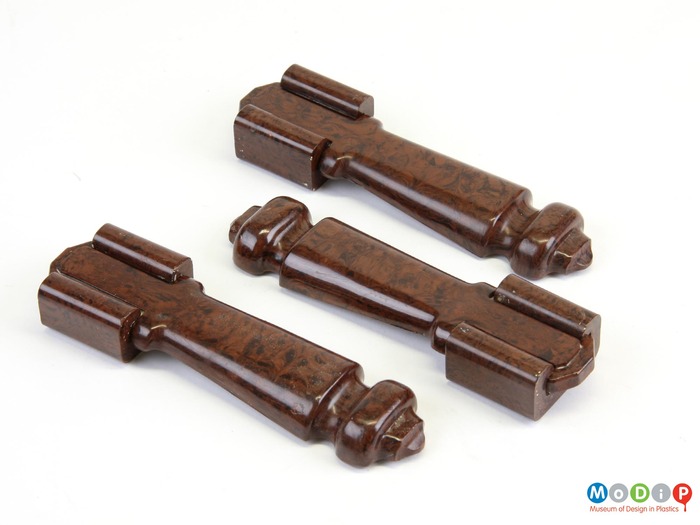Stair carpet clips
Selected as an example of something for which a patent was taken out. These carpet clips received a Good Housekeeping award, which may provide a lead as to the designer and perhaps also the date.


Case number - AIBDC : 005528
A set of 22 compression moulded, phenol formaldehyde stair carpet clips, in an Art Deco style. Each clip comprises two parts: one is drilled to accommodate a screw for fixing to the stair riser, the other slots into it trapping the carpet in place. They were probably in use in the home during the first half of the twentieth century.
View more images on the MoDiP site
View more images on the MoDiP site
| Designer | Unknown - Wanted |
| Manufacturer | Byson |
| Country | UK |
| Date | 1920 - 1959 (circa) - Wanted |
| Dimensions | height 38 mm, width 135 mm, depth 20 mm, diameter mm |
| Materials | plastic, PF, phenol formaldehyde, bakelite - generic term |
| Method | compression moulded |
| Colour | brown |
| Inscription | moulded: ""Byson" Design and method of manufacture Pat. in England & Abroad No. 392800. Tested and approved. Serial 924. Good Housekeeping Institute. Conducted by Good Housekeeping Magazine." (Under clip) |
Images on this site are for non-commercial, educational use only. MoDiP has done its utmost to obtain clearance from all IPR holders before adding images to this catalogue, if you believe that any image has been used without permission please contact us on modip@aub.ac.uk.
Join the hunt at: 10mostinvolved
Facebook Feed
29/08/13
11/10/13
11/10/13
11/10/13
11/10/13
12/10/13
12/10/13
12/10/13
12/10/13
12/10/13
15/10/13
15/10/13
15/10/13
15/10/13
15/10/13
16/10/13
16/10/13
16/10/13
17/10/13
17/10/13
17/10/13
21/10/13
21/10/13
21/10/13
21/10/13
22/10/13
22/10/13
22/10/13
22/10/13
22/10/13
22/10/13
22/10/13














 #10
#10 #10;</body></html>" />
#10;</body></html>" />


Case notes
Stair carpet clips - Case AIBDC : 005528
Patent found: E Harrison of Bury was the applicant
10/16/2013
The full patent listing can be seen here: http://worldwide.espacenet.com/publicationDetails/biblio...
A brilliant start. Now we need to find out what was Ernest Harrison’s role? Was he their designer/inventor or the owner of a company that produced them?
Proof the clips were in production at least from 1934 to 1937
12/10/13
It has been found that the clips were exhibited at both the 1934 and 1937 White City British Industries Fairs. At the 1934 Fair, Byson Appliance are listed as producers of "Stair-Carpet-Holders (non-metal_ Made from Bysonite in Oak, Walnut, Mahogany, Black Green and Orange Colours. Their exhibition at the 1937 British Industries Fair: is referred to here http://www.gracesguide.co.uk/Byson_Appliance_Co. An additional discovery is an article from "Newspaper world, 1935" stating that there was trade advertising for 'Byson Stair Carpet Grips'.
So we know that that the design made it into production. We still need to find out Ernest Harrison's role.
Byson Appliance Co. and E Harrison are connected
17/10/2013
It has been pointed out that Byson Appliance Co and Harrison. E, both located in Bury, seem to be associated together with at least 9 patents, dated between 1938-1952, all related to curtains, carpets and home maintenance: http://www.patentmaps.com/assignee/Byson_Appliance_1.html.
This suggests that Harrison was either owner of or employee at Byson. Which was he?
A box of carpet clips
17/10/2013
Proof that Ernest Harrison is their inventor
22/10/2012
Phil Blume finds a Canadian website written by Rosemary Phillips in which she tells of her grandfather, Ernest Harrison, inventing a bread slicer in 1927 and this being the "beginning of an inventors creative career" and emails her to ask if she knows of any connection between her grandfather, Ernest Harrison, and the Ernest Harrison of Bury, Lancashire, who is the focus of our enquiry.
Rosemary Phillips in which she tells of her grandfather, Ernest Harrison, inventing a bread slicer in 1927 and this being the "beginning of an inventors creative career" and emails her to ask if she knows of any connection between her grandfather, Ernest Harrison, and the Ernest Harrison of Bury, Lancashire, who is the focus of our enquiry.
He received this reply:
You can find Rosemary's website here:http://www.quillsquotesandnotes.com/bite-bread.htm
Brilliant outcome.
Case closed
Designer: Ernest Harrison
Date: 1932
Participating Agents: Rupert Radcliffe, Stephen Hill, Rosemary Phillips, and Yvonne for introducing new Field Agents to the game. Information was also provided by someone who wishes to be anonymous.
Yvonne for introducing new Field Agents to the game. Information was also provided by someone who wishes to be anonymous.
In the evidence locker: two chapters from Rosemary Phillips' book 'Sliced Bread'.